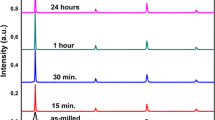Abstract
The relationship between the nanohardness and the microstructures in the Fe–C martensite was studied to understand the contributions of the matrix and the grain boundary to the macroscopic strength. As-quenched martensite was examined for five kinds of Fe–C alloys with various carbon contents in the range of 0.1–0.8 mass%, while quench-tempered martensite was investigated for an Fe–0.4% C alloy. The ratio of the nanohardness to the macrohardness H n/H v was much smaller for the Fe–C martensite than those for the single crystals, indicating that there is a significant grain-boundary effect for the martensite. The ratio H n/H v of the as-quenched martensite decreased with an increase in the carbon content since the size of the block structure decreased with increasing carbon content. For the quench-tempered specimens, a significant reduction of the grain-boundary effect occured at the tempering temperature of 723 K. It is mainly due to the depression of the locking parameter caused by the disappearance of the film-like carbides on the boundaries.
Similar content being viewed by others
References
W.C. Leslie and R.J. Sober, Trans. ASM 60, 459 (1967).
L-A. Norstrom, Scand. J. Metall. 5, 159 (1976).
F.B. Pickering, Hardenability Concepts with Applications to Steel (AIME, Warrendale, PA, 1978), p. 179.
G. Krauss, Hardenability Concepts with Applications to Steel (AIME, Warrendale, PA, 1978), p. 229.
G. Krauss, Mater. Sci. Eng. A273-275, 40 (1999).
A.R. Marder and G. Krauss, Trans. ASM 60, 651 (1967).
J.M. Marder and A.R. Marder, Trans. ASM 62, 1 (1969).
A.R. Marder and G. Krauss, Trans. ASM 62, 957 (1969).
T. Maki, K. Tsuzaki, and I. Tamura, Trans ISIJ 20, 207 (1980).
T. Ohmura, K. Tsuzaki, and S. Matsuoka, Scripta Mater. 45, 889 (2001).
T. Ohmura, K. Tsuzaki, and S. Matsuoka, Philos. Mag. A 82, 1903 (2002).
W.C. Oliver and G.M. Pharr, J. Mater. Res. 7, 1564 (1992).
P. Dörnen and W. Hofman, Arch. Eisenhütt 30, 627 (1959).
M. Itokazu and Y. Murakami, Trans. Jpn. Soc. Mech. Eng. A 59, 2560 (1993).
K. Miyahara, S. Matsuoka, and T. Hayashi, Metall. Mater. Trans. 32A, 761 (2001).
R.N. Caron and G. Krauss, Metall. Trans. 3, 2381 (1972).
Author information
Authors and Affiliations
Rights and permissions
About this article
Cite this article
Ohmura, T., Hara, T. & Tsuzaki, K. Relationship between nanohardness and microstructures in high-purity Fe–C as-quenched and quench-tempered martensite. Journal of Materials Research 18, 1465–1470 (2003). https://doi.org/10.1557/JMR.2003.0201
Received:
Accepted:
Published:
Issue Date:
DOI: https://doi.org/10.1557/JMR.2003.0201




